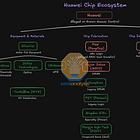Lagging Edge will have a Permanent Glut
The direction is clear, the lagging edge with exposure to Chinese markets will have a glut.
Hey, it’s been a bit of time. I have been swamped at SemiAnalysis. Remember, most of the best work happening in Semiconductors and AI is already underway at SemiAnalysis. We offer a diverse range of products, as well as numerous job opportunities available. We are currently hiring for various roles, including accounting, general operations, sales, and data engineering.
Today’s post mixes free and paid content. First up: Texas Instruments. TI’s quarter was rough—optimism that the analog cycle had finally turned fizzled when management said it would cut inventory into the supposed “upturn.”
As I alluded to earlier, given the inventory position that we have right now and depending on what happens on revenue next year, we may need to adjust factory loading down in the coming quarters for a few quarters until we rectify the inventory situation a bit and just stop it from growing and maybe drain it -- and not maybe likely drain it for a few quarters. So that would put a headwind on gross margins, but it should be temporary for a few quarters until we rectify the inventory situation.
They’re now guiding to the low end of capex, signaling the COVID-era grand capex plan may never be needed. Texas Instruments also guided another disappointing quarter; extending the lagging-edge slow-motion train wreck.
This is the tail of the long auto/industrial cycle: a huge upswing followed by a slow bleed. The glut has run roughly twice as long as a typical downturn, and even the “green shoots” were tariff-distorted.
April’s pop was mostly pull-forward; that tariff-driven pull-forward was taken as fake demand.
Those were pretty strong January through April. And April, in particular, were really strong. And we think some of that was due to the Liberation Day and some of the dynamics that happened there. But then things did slow down after April, or at least didn't grow as they normally would have a month on month on month. And again, some of that was the Liberation Day potential pull-ins. And we talked about that at some length at our July earnings release call.
And since then, it’s been slowly bleeding out in terms of the pull-ins. The run rate of demand is actually lower.
My sense is not just with TI, but the industry as a whole, the tone was a little different in April and May than it was in July and August. And maybe nothing quantified, but the tone. And I think that was a function of those orders the order trends that I referred to earlier that April was pretty strong. And -- but it appears that some of that was pulling Again, it's hard to tell with so many permutations on orders and customers, but it looks like some of that was pull-ins.
There is no lagging-edge upcycle. Global capacity looks bloated, especially in categories competing with China’s lower-end offerings, where TI sits. Supply and demand here are fragile to small changes; the swing factor is incremental Chinese demand.
Even a 5% supply uptick in an “upswing” would sap incumbents’ pricing power and impair the value of their capacity. With utilization still lackluster globally, the writing is on the wall.
The Auto and Industrial inventory cycle is as bad as it has ever been. Stocks are waking up to a structurally inflated low end driven by China. I wrote about the edge price war in 2023, and it has been a one-way slog since.
Lagging-edge capacity now behaves differently. Another upturn may come, but it should be muted and prolonged. Something is broken in auto and industrial. TI is right to run inventories down; they likely will not need as much.
Lagging Edge Perma Glut
What no one wants to admit: lagging-edge capacity may be structurally different now. Earlier, I argued prices had to rise because a new fab cannot profit from selling a lagging-edge chip at prices set by a fully depreciated fab.
There are obvious pricing problems in this scenario. With a new fab, a company can’t turn a profit selling a lagging-edge chip at the price that was previously dictated by a fully depreciated fab. Prices have to go up.
Reality: the lagging edge took price in a temporary market upturn; now we are reverting to the mean. The old trend line is back. There is no meaningful new demand for old nodes, and what exists is made and consumed in China. The COVID super-cycle, plus a new China supply line that does not care about capacity economics, points to a forever glut.
China has a long record of flooding the low end. State-directed capex boosts output at the expense of efficiency. I wrote about this “involution” dynamic recently.
Products at 90 nm and above should internalize a permanent China glut. Companies resist that conclusion, but the case studies are familiar: solar modules, LCDs, LEDs, steel, shipbuilding, batteries.
Companies can still win share, but through performance and packaging rather than by producing older chips at lower cost. ADI is a master class in adding capabilities; MPWR has focused on higher-end power.
The long tail will face a flood of Chinese supply. Good luck to the older fabs.
I cannot resist talking about Marvell behind the paywall.



